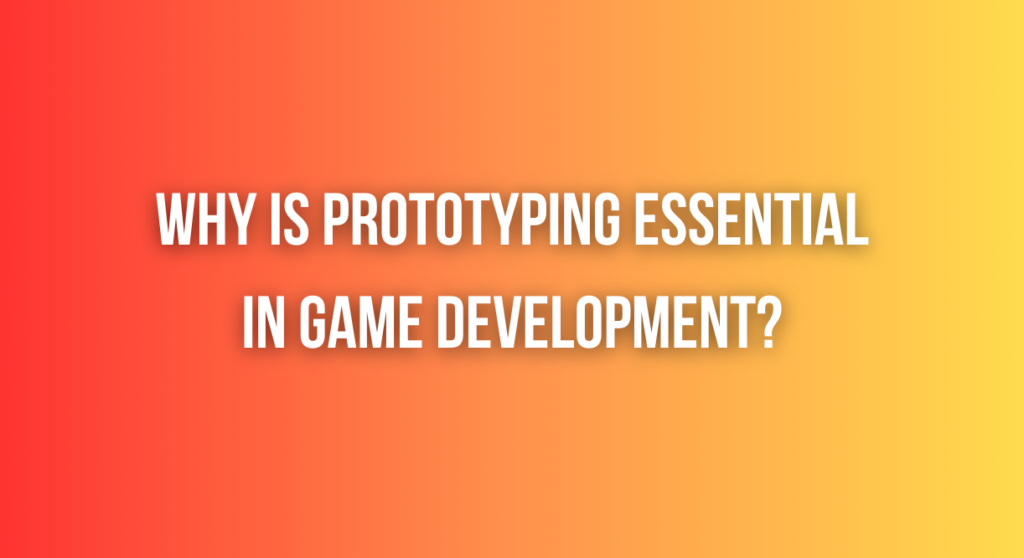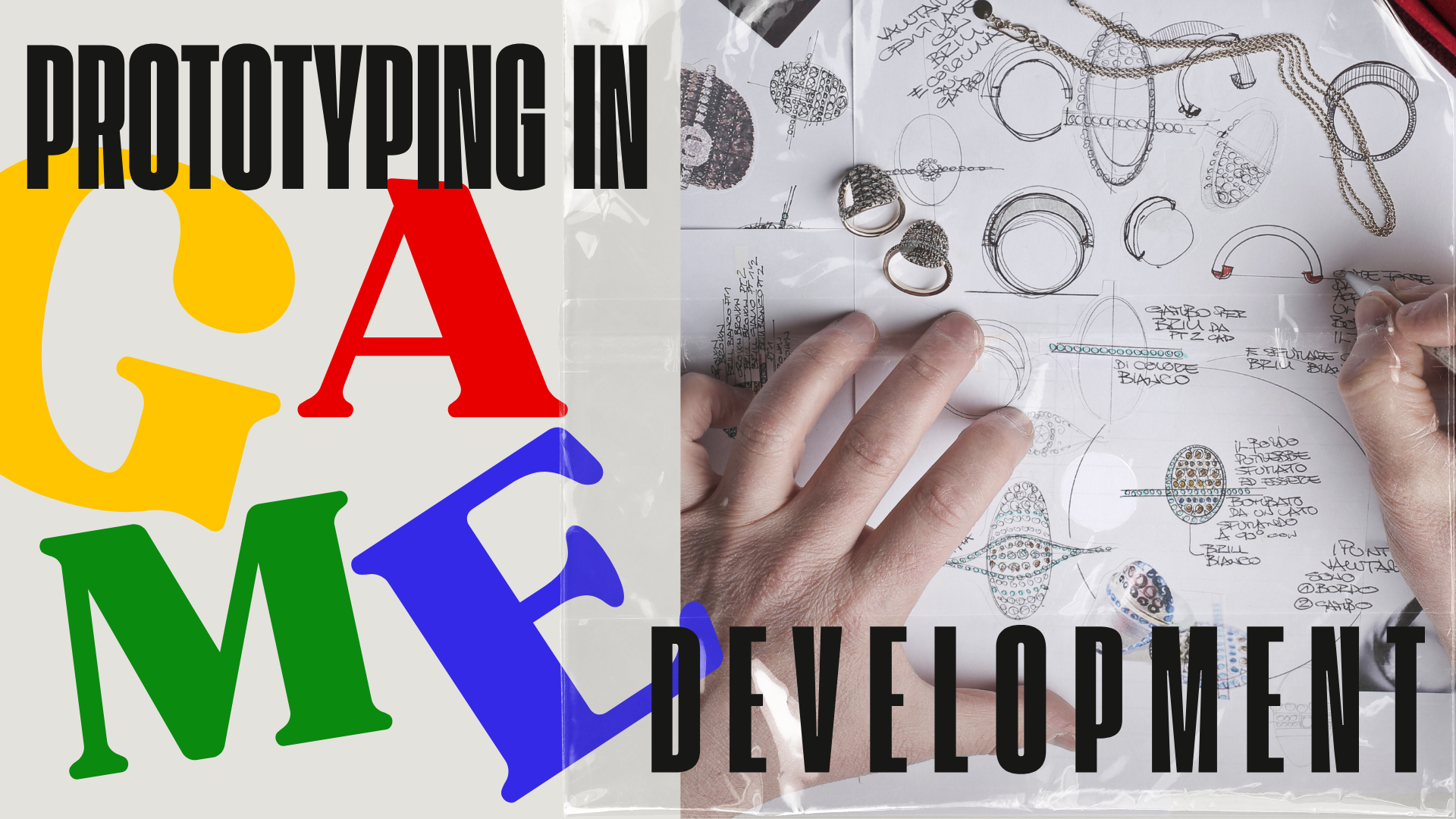Prototyping in Game Development: The Ultimate Secret to Building Better Games
Introduction:
Prototyping is a critical aspect of the game development process. Whether you’re an indie developer or part of a larger team, creating prototypes helps bring game concepts to life in a tangible way. But why exactly is prototyping so essential, and how can intermediate developers make the most of this phase? This blog will walk you through the importance of prototyping in game development, offering practical tips to help you refine your ideas and build stronger games. Readers will learn why prototyping is indispensable and discover how to prototype effectively, leading to smoother development processes and better final products.
Why is Prototyping Essential in Game Development?

Prototyping is the backbone of the game development process. It is an indispensable phase where game developers take their initial ideas and transform them into something tangible. Without a prototype, it’s difficult to assess how a game will feel, whether its mechanics work, or if players will enjoy the experience. Here are the key reasons why prototyping is essential for game developers:
1.1 Validates Game Concepts Early
When you first come up with an idea for a game, it might sound amazing on paper, but ideas are intangible, and what works in theory doesn’t always work in practice. Prototyping provides an opportunity to turn an abstract idea into a playable form, so developers can evaluate whether the core mechanics are fun or engaging.
For example, you may have a brilliant concept for a unique combat system, but until you prototype it and allow players to engage with the mechanics, it’s hard to know if it’s enjoyable or intuitive. A prototype allows you to rapidly identify if the game concept holds up under real-world conditions or if it needs adjustment.
1.2 Detects and Fixes Design Flaws Early
Prototypes serve as an early testbed for uncovering design flaws or mechanical weaknesses that are not visible during the conceptualization phase. Game mechanics that seem perfectly viable during planning can sometimes turn out to be too complex, too simple, or even broken when put into practice.
Consider a game with an elaborate leveling system. In theory, it could seem like a great idea, but during prototyping, you might find that the system is too convoluted, making the game less enjoyable for players. Without prototyping, these flaws may only come to light during later stages of development, which would be more costly and time-consuming to fix.
1.3 Saves Time and Resources
Prototyping helps developers avoid the classic pitfall of creating detailed assets, levels, and systems that don’t ultimately work with the game’s mechanics. By focusing on the core mechanics first, developers save valuable time by not getting bogged down in the details too early.
For instance, if you prototype and discover that your game’s camera angles make the gameplay confusing, you can adjust the mechanics early on. This saves you from needing to redo artwork, animations, or user interface (UI) elements that would have been designed for a faulty system.
1.4 Encourages Creativity and Innovation
Prototyping encourages experimentation. Since developers are not immediately tied to a final product, they have more creative freedom to try new ideas, test different mechanics, and tweak gameplay elements. In fact, some of the most innovative features in games come from experimentation during the prototyping phase.
Take the example of the game Celeste, which was developed from a prototype built in just four days during a game jam. Through rapid prototyping, the developers experimented with level designs, difficulty mechanics, and character abilities, resulting in a refined and engaging platformer that went on to win multiple awards.
1.5 Improves Communication Between Teams and Stakeholders
A working prototype can help bridge communication gaps between different members of a development team, as well as with stakeholders like investors or publishers. It’s easier for people to understand the vision of a game when they can interact with a prototype rather than trying to imagine it based on a design document.
In larger development teams, prototypes help designers, programmers, and artists align on the game’s goals. For smaller, indie developers, a prototype can be the key to securing funding or gaining feedback from potential players. In either case, having a tangible, playable version of the game is an invaluable tool for getting others on board with your vision.
How Can Intermediate Developers Effectively Prototype Their Game Ideas?

For intermediate developers, prototyping can be both exciting and challenging. You may already have the foundational skills to code, design, and build a game, but knowing how to streamline your ideas into a working prototype takes strategy. The key is to focus on what’s important and use the right tools and methods to bring your concepts to life quickly and effectively.
2.1 Start Simple: Focus on Core Mechanics
The most common mistake that intermediate developers make during prototyping is trying to include too much too soon. A prototype should concentrate on the game’s core mechanics—the key elements that will define the player’s experience.
Let’s say you’re developing a platformer. Rather than trying to implement a full range of levels, character designs, and narratives, focus first on how the character moves and interacts with the environment. Is the jumping mechanic responsive? Does the player feel in control? A polished prototype focusing on movement alone can reveal more about the potential success of your game than a half-finished project with multiple unrefined systems.
2.2 Use Prototyping Tools for Quick Iteration
One of the major advantages modern game developers have is access to a variety of game engines and prototyping tools. Game engines like Unity and Unreal Engine allow for quick prototyping through the use of templates, asset stores, and even visual scripting tools like Unity’s Bolt or Unreal’s Blueprint system.
- Unity: Unity is an excellent tool for quick prototyping due to its flexibility and ease of use for both 2D and 3D games. Unity’s Asset Store provides developers with pre-made assets, making it easier to focus on gameplay rather than art creation. For intermediate developers, Unity’s visual scripting features help cut down on time spent writing code, allowing you to concentrate on refining gameplay mechanics.
- Unreal Engine: Unreal’s Blueprint system is a great way for intermediate developers to create prototypes without extensive coding knowledge. It offers a visual interface for scripting game logic, making it faster to build and iterate on ideas. Unreal Engine also offers an impressive range of high-quality graphical assets for more visually ambitious prototypes.
- GameMaker Studio: Another powerful prototyping tool for developers focusing on 2D games, GameMaker Studio is especially useful for creating simple, sprite-based games quickly. Its drag-and-drop system allows developers to rapidly put together working prototypes without the need to dive deep into code.
- GDevelop: GDevelop is a free, open-source engine that allows developers to create prototypes without needing programming skills. Its visual scripting system is easy to understand, making it ideal for intermediate developers who want to prototype quickly while still being able to explore more complex mechanics.
2.3 Iterate Rapidly: Don’t Aim for Perfection
One of the biggest challenges developers face when prototyping is the temptation to perfect every detail. Prototypes are meant to be rough, quick, and subject to change. As an intermediate developer, it’s essential to focus on creating multiple iterations rather than getting stuck on a single version.
For example, if you’re working on a puzzle game, build several quick variations of the puzzle mechanics and see how each version plays out. Don’t worry if the graphics are placeholders or the controls are a bit clunky—that’s all part of the iterative process. What matters most is the gameplay.
By adopting a mindset of rapid iteration, you’re able to test more ideas, discover what works, and, importantly, what doesn’t. This approach also means you can pivot more easily if a particular game mechanic doesn’t turn out the way you envisioned.
2.4 Seek Feedback Early and Often
Feedback is essential to the prototyping process. While it can be tempting to wait until you have something polished, seeking feedback early allows you to refine your ideas before committing too much time and effort to flawed mechanics.
Sharing your prototype with other developers, friends, or even online communities (like Reddit’s GameDev or indie game development Discord groups) can offer invaluable insights. Feedback from people outside your immediate development circle often highlights issues or opportunities for improvement that you may have overlooked.
Even if your prototype is far from finished, early testers can help you identify aspects of the gameplay that are fun or frustrating, giving you direction for further iteration. They might suggest ways to simplify a mechanic, provide ideas for improving user interface design, or simply confirm that your core concept is enjoyable.
2.5 Keep Your Prototype Playable
Your prototype doesn’t need to be polished, but it should always be playable. This means focusing on making sure that the core gameplay loop functions correctly. Playability is key to testing how engaging your core mechanics are and whether or not the game has the potential to grow into a fully developed product.
If your prototype crashes constantly or is too confusing to navigate, it will be difficult to assess its true potential. Even if the prototype is simple, ensuring that players can easily engage with it means you’ll be able to collect valuable data on how they interact with your game.
2.6 Document Your Learnings
Every prototype you create is a learning experience. As you build and iterate, make sure to take notes on what works and what doesn’t. Reflecting on each prototype helps you refine your approach, not just for the game you’re working on but also for future projects.
For example, you might discover that a certain control scheme felt unintuitive, or that players preferred a simplified version of your combat system. By documenting these insights, you’re better equipped to avoid similar issues in future prototypes, making your development process more efficient over time.
Frequently Asked Questions (FAQ)
As an intermediate developer diving deeper into prototyping, you may encounter various questions about the process. Below are some of the most common questions related to game development and prototyping, with clear, informative answers to guide you.
1 What is the main purpose of prototyping in game development?
The main purpose of prototyping is to test and validate core game mechanics early in the development process. A prototype helps developers see if the game’s primary concepts work in practice, allowing for early detection of flaws, necessary adjustments, and opportunities for creative innovation. It serves as an experimental phase where developers can quickly build and iterate on ideas without committing too many resources.
2 How long should a prototype take to develop?
There is no fixed timeline for developing a prototype, as it depends on the complexity of the game idea. However, prototypes should generally be created quickly—often within a few days or weeks. The goal is to test key mechanics or features, so it’s important not to get bogged down with perfection. Prototypes are meant to be functional rather than polished, allowing developers to move swiftly through iterations.
3 Do I need to create a complete game in the prototyping phase?
No, the goal of prototyping is not to build a complete game. Instead, you should focus on developing a small, playable slice of the game that demonstrates its core mechanics and gameplay loop. The prototype might only include one or two levels or a few key interactions, but these elements should be representative of the overall game experience. The objective is to gather feedback and validate your ideas before moving into full production.
4 How can I improve my prototyping skills as an intermediate developer?
To improve your prototyping skills, practice rapid iteration, work with different game engines, and focus on the core mechanics of the games you create. Participate in game jams, which are great for honing your ability to quickly develop prototypes under tight deadlines. Additionally, seek feedback from other developers and players to understand what works and what doesn’t. By documenting what you learn from each prototype, you can refine your process and become more efficient in future projects.
5 What tools are best for prototyping games?
The best tools for prototyping depend on the type of game you’re developing. For 2D games, tools like GameMaker Studio, GDevelop, and Construct are ideal for quick prototyping. For 3D games, Unity and Unreal Engine are popular choices, thanks to their built-in assets and robust prototyping features like visual scripting. If you’re creating interactive fiction or narrative-driven games, Twine or Ink might be more suitable.
6 Should I worry about art and sound during the prototyping phase?
While visuals and sound are important aspects of a game, they are not the focus during the prototyping phase. Prototypes are primarily about testing gameplay mechanics and systems, so using placeholder art, simple shapes, or default sounds is perfectly fine. You can polish the art, sound, and visual design after you’ve validated the gameplay through prototyping.
7 How do I know when my prototype is ready for full development?
Your prototype is ready for full development when the core mechanics have been tested and refined, and when you are confident that the gameplay experience is enjoyable and engaging. Additionally, you should have a clear vision of how the game will expand from its prototype state into a complete product. If you’ve received positive feedback from players and addressed major design flaws, it’s a good indicator that you’re ready to move forward with full production.
Case Studies: Successful Games Developed Through Prototyping

1 Celeste
Celeste, developed by Maddy Makes Games, is a perfect example of how rapid prototyping can lead to an award-winning product. Initially created during a game jam in just four days, Celeste started as a simple platformer with tight, responsive mechanics. The developers focused on getting the core mechanics—climbing and jumping—just right during the prototyping phase, and they continued to iterate and refine these mechanics throughout development. This attention to detail and rapid iteration helped Celeste evolve into one of the most beloved indie games of recent years.
Lessons Learned: Prototyping allowed the developers to experiment with various level designs and difficulty mechanics, ensuring that the core gameplay felt polished before adding narrative and visual elements.
2 Hades
Hades by Supergiant Games is another success story that highlights the importance of prototyping. The team used a process known as “early access prototyping,” where they released a playable version of the game to the public during development. This approach allowed them to gather feedback from players and make improvements over time. The result was a highly refined action game with excellent pacing and engaging mechanics.
Lessons Learned: Gathering feedback early, even before the game is fully complete, can be an invaluable way to identify areas for improvement and refine the player’s experience.
3 Hollow Knight
Hollow Knight by Team Cherry started as a simple prototype that focused on delivering precise and fluid character movement. During prototyping, the developers concentrated on creating a responsive platforming experience, refining the jump, attack, and dodge mechanics. Once the core movement system was perfected, they expanded the game world, story, and art style.
Lessons Learned: A strong prototype focusing on a game’s most fundamental mechanics can serve as the foundation for creating a much larger, more complex game later.
Key Takeaways and Recommendations

Prototyping is a critical part of the game development process, offering a low-cost, high-reward way to validate ideas, refine mechanics, and ensure that your game will be fun and engaging before entering full production. By rapidly testing and iterating on game concepts, you can avoid costly mistakes later in the development cycle and create a more polished final product.
Key Takeaways:
- Prototyping helps validate game concepts, identify design flaws early, and save time and resources.
- Intermediate developers should focus on core mechanics, iterate quickly, and seek feedback often.
- Tools like Unity, Unreal Engine, GameMaker Studio, and GDevelop make prototyping easier and more accessible.
- Case studies like Celeste and Hades demonstrate the power of prototyping in developing successful games.
Recommendations:
- Start small and simple—focus on building a prototype that tests one or two core mechanics before expanding.
- Use available tools and assets to speed up the prototyping process.
- Don’t aim for perfection. Instead, create multiple iterations and seek feedback to refine your ideas.
- Get involved with game jams or online communities to further develop your prototyping skills.
Story Time: The Importance of Prototyping in Game Development

Imagine you’re an aspiring game developer named Alex. You’ve been dreaming of creating your very own video game for years, and finally, you’ve come up with the perfect idea—a platformer where players control a robot that can switch between gravity modes to solve puzzles. It’s a unique idea, and you’re excited to get started. You open your computer, fire up your favorite game engine, and begin working.
But after a few weeks, you start hitting some walls. The controls don’t feel quite right, the puzzles are harder than you expected to design, and the gravity switching feature—your game’s most important mechanic—just isn’t as fun as you thought. You’re overwhelmed because you’ve spent so much time and energy building parts of the game already. You realize that if you keep going like this, you might waste even more time on a game that’s not as enjoyable as you imagined.
This is where prototyping comes in.
Instead of building the entire game from scratch, Alex could have saved a lot of time by creating a prototype—a basic, rough version of the game, designed to test out the core mechanics.
Let’s rewind the story a bit.
Back to the Beginning: The Power of a Prototype
Before jumping headfirst into development, Alex could have started by building a quick prototype. Instead of spending weeks making art, designing levels, or writing code for things like menus or game settings, Alex focuses on the core mechanic: the robot’s gravity-switching ability.
In just a few days, Alex builds a simple version of the game. There’s no fancy art—just simple shapes representing the robot and the platforms. The puzzles are basic, and there’s only one level. But that’s the whole point. This prototype exists to see if the gravity-switching mechanic is fun.
Alex starts playtesting the prototype. It doesn’t feel quite right at first—the gravity switch happens too fast, making the game confusing to play. But since Alex kept the prototype simple, tweaking and adjusting it is easy. After some fine-tuning, Alex finds the sweet spot where switching gravity feels satisfying and fun.
Learning from Mistakes Early
As Alex continues working on the prototype, something interesting happens. While testing out the gravity-switching mechanic, Alex realizes that the puzzles aren’t as exciting as expected. The feature is fun, but the game might need a different challenge. Instead of giving up, Alex experiments with some new ideas. What if the robot could also control time? What if the puzzles involved using both gravity and time manipulation?
Since the prototype is simple, Alex can easily add in these new ideas and test them without spending weeks of development time. After a few experiments, Alex discovers a new and much more engaging combination of gravity and time puzzles that work perfectly together.
Now, Alex feels much more confident about the game’s direction. The prototype has confirmed that the gravity mechanic works, and experimenting with time control has opened up exciting new possibilities for puzzles.
Moving to Full Development
After spending just a couple of weeks on the prototype, Alex has learned more about the game than months of full-scale development could have taught. The prototype has shown what works, what doesn’t, and how the game can be improved.
Because of this, when Alex starts working on the full game, there’s no guesswork. Alex can focus on building polished levels, creating beautiful art, and crafting a compelling story, knowing that the gameplay mechanics have already been validated.
The result? A much smoother development process and a game that’s not only fun to play but also unique, thanks to the lessons learned from the prototype.
The Moral of the Story
Prototyping is like creating a rough draft of your game. It lets you try out new ideas, see what works, and fix what doesn’t—all before you invest too much time and energy into building the full game. It’s your chance to experiment, learn, and improve.
So, next time you have a brilliant game idea like Alex, don’t rush straight into development. Instead, start small. Build a prototype. Play around with it. Test your ideas and make sure they’re fun. By doing this, you’ll save time, avoid frustration, and give your game the best chance of success.
After all, just like in Alex’s case, prototyping can be the difference between a game that struggles and a game that shines.
Download our Game : Infinite Blitz
















What do you think?
It is nice to know your opinion. Leave a comment.